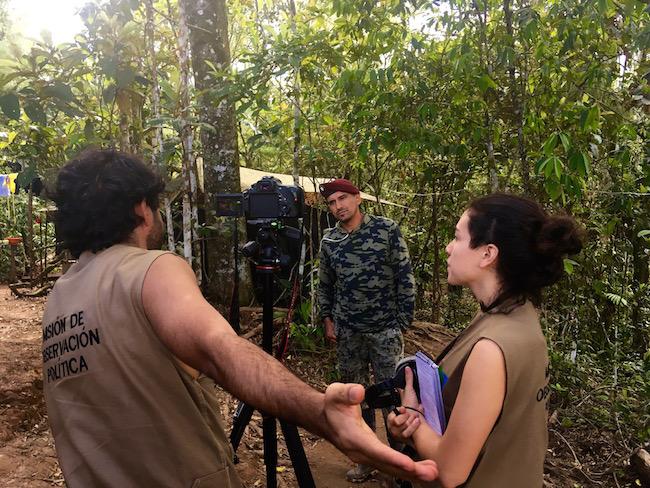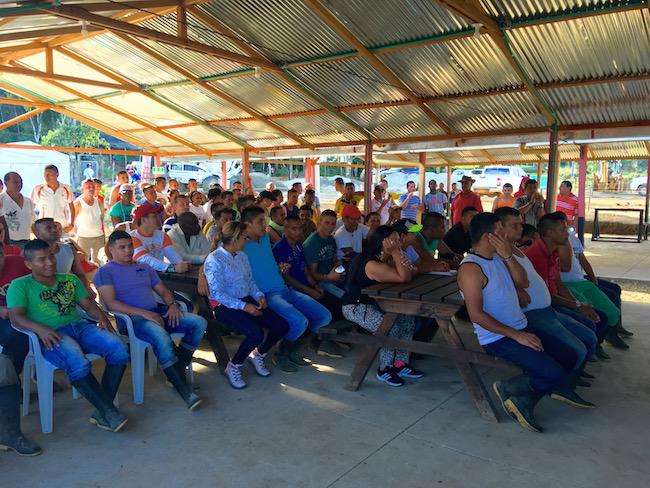
In the Colombian department of Meta, a few hours south of Bogotá, a bumpy dirt road branches off the highway and snakes through rugged greenery 3,000 meters above sea level. The vehicle I’m traveling in follows it until, after an hour, we reach a military checkpoint where officers briefly question our group before a barrier is raised and we move on.
Further ahead, a large hand-painted sign announces our destination: the Zona Veredal de Transición y Normalización (Transitional Local Zones for Normalization, ZVTN) Mariana Paz, named after Mariana Paz, a member of the Revolutionary Armed Forces of Colombia (FARC) who was killed in a government airstrike in 2009. The 500 guerrillas who have come to the camp to demobilize—as part of the implementation of Colombia’s peace agreement— have named the camp after her.
I’m accompanying an official delegation of the Foro de São Paulo, an alliance of left, center-left and progressive political parties and movements from across Latin America and the Caribbean, formed in Brazil in 1990. The delegation is in Colombia to observe the complex application of the country’s peace accords, which seek a negotiated and enduring settlement to Colombia’s 50-year long civil war. After meeting in Bogotá with everyone from the vice-president to victims’ associations, Foro delegates have come to Meta to assess the fledgling post-conflict scenario from the FARC perspective.
The delegation’s head is Monica Valente, the Foro’s Executive Secretary and member of Brazil’s Workers’ Party (PT). “We’re here to verify, observe and, as much as possible, help to ensure that the accords are implemented in full,” she says. “International organizations can bring the peace process visibility and for the Foro de São Paulo, this can help us build strong solidarity among people.”
The ZVTN Mariana Paz is one of 26 camps across Colombia where FARC members are living throughout the initial post-conflict period. Although the accords stipulate a six-month demobilization period, significant hitches in implementation have delayed the entire process, leaving guerrillas unsure as to when they will complete the transition to civilian life. While stationed in the camps, FARC members will receive educational and labor training to help them reintegrate into Colombian society as the organization prepares for its next phase as a formal political party. They will also disarm, with the United Nations—not the government— responsible for receiving the guerrillas’ weapons. This is a very important detail: handing weapons to the government would constitute a surrender.
Problems in the field are mounting, however, where state inefficiencies and incompetence have dogged the ZVTN camps. Although most FARC members arrived over three months ago, the ZVTN Mariana Paz lacks decent kitchen and sanitation facilities. Tarpaulins stretched across bamboo frames constitute the accommodation. Basics such as toothbrushes, toilet paper and soap are in scant supply.
“Around 60 percent of the buildings are completed,” says Carolina García, a FARC member at the camp. “But the sanitation facilities aren’t ready, nor is the food preparation area. They also need to finish constructing accommodation for comrades who are coming out of prison.” According to García, international pressure on the government is having an impact in areas such as improving living conditions in the camps.
The government’s inability to provide adequate construction and preparation has obliged the FARC to construct their own quarters and communal spaces. Fortunately, years spent as a guerrilla force in the Andean cordilleras means they are accustomed to unorthodox living conditions. In addition to the ZVTN’s improvised facilities, residents have established a football pitch, hosting a women’s soccer game when we arrive. Just beyond that, a painting workshop encourages guerrillas to commit their visions of peace to canvas.
Despite the physical hardship of the camps and the disquieting bureaucratic developments in Bogotá, the mood in the ZVTN Mariana Paz is friendly and hospitable. Several members of the Foro delegation share their experiences of insurgency and conflict resolution, which are highly germane to the FARC’s current situation. Speakers include Pablo Monsanto of Guatemala’s Convergence Party, who led that country’s guerrilla forces for almost thirty years and Leonel Espinoza of the International Secretariat of Nicaragua’s ruling Sandinista government. Both offer advice to their younger counterparts in the FARC on the challenges of transitioning from rebel armed force to electoral party machine.
Nidia Díaz is a former guerrilla commander in El Salvador’s Farabundo Martí Liberation Front (FMLN) and a lead FMLN negotiator in Nicaragua’s 1992 peace process, who now sits in Nicaragua’s national assembly. The FMLN’s long journey, from armed insurgency to full-fledged political party to governing authority, is one the FARC hopes to follow. Despite the incompleteness of these country’s peace processes, participants like Díaz hope to share the valuable lessons from their own experiences, in solidarity with the FARC’s mission.
“Peace is not only about putting down weapons,” says Díaz. “It’s about rights, and liberties, for the entire population and for all political and social forces. It also starts a process of transformation over land justice and an end to impunity. It means territory no longer being the end of drug cultivation and the creation of illicit crop substitution programs. It means ending the paramilitarism which has caused both moral and physical damage to Colombia, even though unfortunately you can never fully recover from it.” Díaz emphasized the enormity of the task ahead, as many of the demobilized FARC members have known no other life but as guerrillas.
Despite the white flag of peace now raised over Colombia, patterns of politically motivated violence and impunity continue. Armed paramilitaries, drug gangs, and the Ejército Nacional de Liberación (National Liberation Army, ELN), the country’s second-largest guerrilla insurgency, have reportedly rushed in to occupy large territories that the FARC controlled for decades. And so far in 2017, some fifty social activists have been murdered and recent killings have targeted demobilizing FARC members and their families.
Moreover, a May 17 Constitutional Court ruling threatens to sabotage the agreement entirely. The decision allows the Court to reject or make changes to individual aspects of the accords, thereby overruling the original ‘fast track’ mechanism, which recognized the importance of swift implementation. The government’s inability to ensure completion of the terms in the agreement has delayed disarmament, which requires simultaneous implementation of the accords by the state and the FARC. Under the agreement, the government must provide the legal and security guarantees for the FARC it promised under the peace accord – which it has thus far failed to do.

FARC member Carolina García, who sat on the International Commission during the Havana talks, sees the Foro visit as a positive development for the possibility of the government making good on its promises. “The solidarity we receive from different countries is tremendously important for advancing the Colombian peace process.”
According to García, the FARC remain committed to the process. “In the camps, we are optimistic that this can reach a productive conclusion,” she says. “We know that constructing peace is not easy. Peace is not only silencing the guns but also addressing the basic needs of the population.” Her words reflect the overall atmosphere within the camp: t-shirts, flags and signs are all emblazoned with the popular refrain Queremos la paz: We want peace.
Another guerrilla, Karen, who did not provide her last name, affirmed the FARC’s ongoing fight to improve social conditions. “Peace is about feeling committed to all Colombian people,” she says. “Peace is a symbol of reconciliation and forgiveness.” Her hopes for the future include “continuing the struggle for social justice.” This encapsulates the ideas underpinning the FARC transition to civil society, gleaned from interviews with multiple members at the camp: Peace is not the end of the revolutionary goal. The struggle continues, with electoral politics replacing armed conflict as the best path to reshaping Colombian society along more egalitarian lines.
Against much opposition, the FARC political party will launch in late-2017, with the Colombian political right, particularly the Democratic Center party of former president Álvaro Uribe, resolutely opposed to the peace agreement. Presidential elections in 2018 mean there is little time for the FARC to find its feet as a formal party.
While Colombia’s formal left is fragmented, the early phase of the FARC electoral project could see it attempt to build alliances with other domestic parties. This may involve modifying and moderating certain ideals as it seeks to expand beyond traditional rural constituencies into urban areas, something that won’t come easy to a movement steeped in over half a century of rural-based revolutionary socialism. But for now, what’s most pressing is ensuring the constitutional court ruling doesn’t derail the accords and safeguarding demobilizing guerrillas as they enter civil society. The FARC remains determined to navigate a transition to peace. Colombia’s main concern is whether others are committed to the same.
To read the Foro de São Paulo report (in Spanish) on the implementation of Colombia’s peace process, click here.
Nick MacWilliam is an independent journalist and co-editor of Alborada magazine. Follow him on @NickMacWilliam

